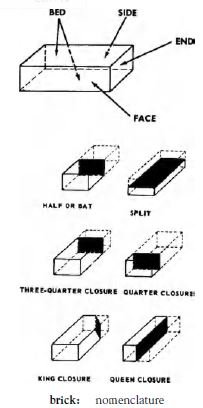A solid masonry unit, usually of clay, molded into a rectangular shape while plastic, and then treated in a kiln at an elevated temperature to harden it, so as to give it mechanical strength and to provide it with resistance to moisture; after being removed from the kiln, the brick is said to be burnt, hard-burnt, kiln-burnt, fired, or hard-fired. Bricks laid lengthwise in a wall are called stretchers; bricks laid crosswise to a wall are called headers. Bricks differ in color, ranging from dark red to rose and salmon, and from pink to blue-black and purple, depending on the type of clay and on the temperature of the kiln in which they were burnt. Various types of patterns common in laying bricks are described under bond. The current American brick is typically about 8 inches (20.3 cm) long, 33 €4 inches (8.26 cm) wide, and 21 €4 inches (5.7 cm) thick; other countries tend to produce bricks with their own standard dimensions. For specific types of brick, see adobe quemado, air brick, angle brick, arch brick, axed brick, brindled brick, building brick, bull stretcher, burnt brick, cant brick, capping brick, closer, common brick, compass brick, concrete brick, coping brick, cow-nose brick, dogleg brick, dog-tooth course, Dutch A solid masonry unit, usually of clay, molded into a rectangular shape while plastic, and then treated in a kiln at an elevated temperature to harden it, so as to give it mechanical strength and to provide it with resistance to moisture; after being removed from the kiln, the brick is said to be burnt, hard-burnt, kiln-burnt, fired, or hard-fired. Bricks laid in a wall are called stretchers; bricks laid crosswise to a wall are called headers. Bricks differ in color, ranging from dark red to rose and salmon, and from pink to blue-black and purple, depending on the type of clay and on the temperature of the kiln in which they were burnt. Various types of patterns common in laying bricks are described under bond. The current American brick is typically about 8 inches (20.3 cm) long, 33 €4 inches (8.26 cm) wide, and 21 €4 inches (5.7 cm) thick; other countries tend to produce bricks with their own standard dimensions. For specific types of brick, see adobe quemado, air brick, angle brick, arch brick, axed brick, brindled brick, building brick, bull stretcher, burnt brick, cant brick, capping brick, closer, common brick, compass brick, concrete brick, coping brick, cow-nose brick, dogleg brick, dog-tooth course, Dutch brick, engineered brick, engineering brick, firebrick, fired brick, flooring brick, gauged brick, glass brick, glazed brick, hard-burnt brick, hollow brick, kiln-fired brick, molded brick, mortar, mud brick, pug-mill brick, pressed brick, radius brick, rough-axed brick, rubbed brick, rustic brick, sailor, salmon brick, sand-faced brick, sand-lime brick, semiengineering brick, soft brick, soldier, solid brick, standard brick, stock brick, twin brick, unburnt brick, vitrified brick, wire-cut brick. See bond for a description of brickwork patterns. Also see adobe for a description of sun-dried brick.
